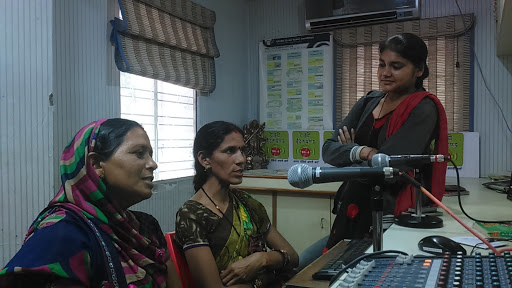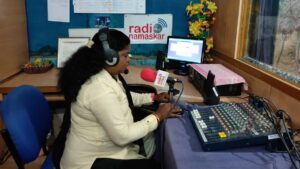World Radio Day 2021: Community radio in India

Community radio serves a community which uses common resources for livelihood and has common development issues & concerns(Photo Credit: IUCN)
“The community radio station, Radio Hevalvani’s interviews with doctors pushed me to get myself tested for the deadly disease,” says Ram Lakhi. “And I tested positive. I did not bother much till I heard about it on the radio. Thankfully, with timely intervention and age being on my side, I have recovered fully now. The radio was my saviour,” he adds.
Ram Lakhi is a 30-year-old farmer from Tehri district of Uttarakhand in northern India. He was diagnosed with Covid-19 early last year, a little before the rest of India was aware of the disease that changed the face of the world forever.
For millions of poor people like Lakhi, community radio networks are playing a pivotal role in disseminating authentic information about Covid-19. As radio is the only window to the outside world for many of these people, community stations have emerged as a vital communication channel since the country went into lockdown on March 24, confining 1.3 billion people to their homes.
In normal times, community stations focus on agricultural issues, farmers’ markets, weather reports and local societal problems. Now, though, their priority is to spread awareness about Covid-19.
From dispelling fake news to reiterating the importance of frequent handwashing and social distancing – as well as issuing alerts about medicines and food distribution – the channels are educating and reassuring rural and semi-urban communities in the remotest corners of the country.
India’s oldest active community radio station
Despite the shift towards digital and mobility devices, community radios are still being used as an important medium to communicate in agricultural and rural areas and have a steady audience. “We have people who still demand songs and women who spend their afternoons listening to the discussions we have about so many issues,” says General Narasamma, one of the two women who run India’s oldest community radio station, Sangam Radio.
She agrees that they have seen a generation of the audience moving on to other digital platforms but is still optimistic as she thinks it keeps their culture and traditions alive and communicates it further. “It is necessary that we keep alive our local traditions and culture and continue to provide valuable insight for our farming community. We still have a very loyal set of audience who are avid listeners. Looking ahead, we feel that despite the shift towards other alternatives, we will strive towards keeping the community radio alive,” she says.
Established on October 15, 2008, and run by Deccan Development Society (DDS) from this tiny village of Pastapur, in Jarasangam Mandal of Medak district in Chattisgarh, Sangam Radio is in its 13th year. The radio station is run by Algol Narsamma and General Narsamma with the help of a team of about 15 women. All of whom have been educated only till Class 10, some even lesser. About 12 field staff – again, all women – visit villages and get the required recordings from farmers, villagers, and fellow women some of whom are invited to the radio station to participate in discussions and other programmes.
“We have very little academic education, but we have been running the Sangam Radio successfully. We want to expand the coverage to double that number,” said Narasamma.
Apart from this all-women radio station, there are over 207 community radio stations in the country, according to a list maintained by the Community Radio Facilitation Centre (CRFC), a department under Ministry of Information and Broadcasting.
“In India, where literacy remains a substantial barrier to development, radio especially community radio, reaches a large number of poor people because it is affordable and uses little electricity which is low supply in many countries and barely affordable for many poor,” adds Narasamma.
Concept of community radio
Community radio is a type of radio service that caters to the interests of a certain area, broadcasting content that is popular with local audience but which may often be overlooked by commercial or mass-media broadcasters, according to UNESCO’s website.
“UNESCO sees community radio as a medium that gives voice to the voiceless, that serves as the mouthpiece of the marginalised and is at the heart of communication and democratic processes within societies,” further reads the website.
Community radio is confined to a small geographical area. Its range depends on transmission power, that often covers a radius of not more than 20-30 km. It serves a community which uses common resources for livelihood, has common development issues and concerns, which are relatively localised, nevertheless connected to national and regional development goals.
Challenges for community radio
There has been a steady increase in the number of community radio stations in the country. But lack of adequate revenue streams and restrictive policies around the coverage area makes it difficult for many of them to sustain operations.
For instance, Sunil Palaskar, in-charge of the community radio station of the Neotech Technical and Management College’s community radio station based in Ambikapur, Chattisgarh, called Neotechtimes, says that the regulation around advertisements is a detriment for stations running without any grant or financial backing.
“The government recently increased the rates of advertisement for all forms of media, except for the community radio. Also, as per regulations, we can only air ads for five minutes per hour. This has made things difficult. The ad timings and rates should be increased for us to sustain our radio station,” Palaskar says.
Limited coverage is yet another hurdle faced by the community radio stations in the country apart from limited advertising revenue potential. According to Devendrappa S, programme officer, University of Agricultural Sciences, Dharwad, Karnataka and Head of Krishi Community Radio, says “We would like the government to consider our suggestions on increasing the coverage area of community radios, which is restricted to 22 km right now. In agriculturally dominant areas, a wider outreach can help farmers adopt newer techniques and improve efficiency.”
For most radio stations, maintenance costs are also a concern. Radio Vasundhara, a devoted community radio station that caters to farmers in and around Baramati in Pune district of Maharashtra, spends close to INR 10,000 per month to maintain their bell transmitter and computer systems at the central office. This takes away most of their revenue.
“We save up on costs because our parent institute (Vidhya Pratishthan’s Institute of Information Technology) provides us with staff to help us with maintenance,” says Yuvaraj Mohan Jadhav, a member of the team that runs Vasundhara Radio.
The accolades
In the southern state of Kerala, Community Radio Mattoli is the state’s first community radio to broadcast in the indigenous ‘Paniya’ tribal dialect. Located in Wayanad district, and run by the non-profit Wayanad Social Service Society since 2009, the network caters to 350,000 listeners.
“We have 24 hours of daily broadcasting of 80 varieties of programs and cover 85 pc of Wayanad district,’’ says station director Bijo Thomas Karukappally.
The station is helping the local administration to whittle down the spread of Covid-19, minimise loss of life among health care professionals and augment mass awareness. But the lockdown has also presented it with a unique opportunity to tackle the district’s pervasive alcoholism problem. To help those impacted by the closure of liquor shops, the channel is telling listeners how to contact support organisations and addiction centres.
“Our employees get very modest salaries and our infrastructure is also very basic. But we’re happy that we are amplifying the voices of the most vulnerable and marginalized sections of society,” says Karukappally, “Their empowerment is our strength. People trust us. It is a great feeling.”










